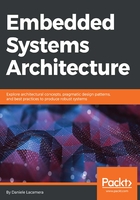
Embedded Linux systems
One part of the embedded market relies on devices with enough power and resources to run a variant of the GNU/Linux operating system. These systems, often referred to as embedded Linux, are outside the scope of this book, as their development includes different strategies of design and integration of the components. A typical hardware platform that is capable of running a system based on the Linux kernel is equipped with a reasonably large amount of RAM, up to a few gigabytes, and sufficient storage space on board to store all the software components provided in the GNU/Linux distribution. Additionally, for Linux memory management to provide separate virtual address spaces to each process on the system, the hardware must be equipped with a memory management unit (MMU), a hardware component that assists the OS in translating physical addresses to virtual addresses, and vice versa, at runtime.
This class of devices presents different characteristics that are often overkill for building tailored solutions, which can use a much simpler design and reduce the production costs of the single units. Hardware manufacturers and chip designers have researched new techniques to improve the performance of microcontroller-based systems, providing, in the past decade, a new generation of platforms that would cut hardware costs, firmware complexity, size, and power consumption to provide a set of features that are most interesting for the embedded market.
Due to their specifications, in some real-life scenarios, embedded systems must be able to execute a series of tasks within a short, measurable, and predictable amount of time. These kinds of systems are called real-time systems, and differ from the approach of multi-task computing used in desktops, servers, and mobile phones. Real-time processing is a goal that is extremely hard, if not impossible, to reach on embedded Linux platforms. The Linux kernel is not designed for hard real-time processing, and even if patches are available to modify the kernel scheduler to help meet these requirements, the results are not comparable to bare-metal, constrained systems that are designed with this purpose in mind.
Some other application domains, such as battery-powered and energy-harvesting devices, can benefit from the low power consumption capabilities of smaller embedded devices and the energy efficiency of the wireless communication technologies often integrated in embedded connected devices. The higher amount of resources and the increased hardware complexity of Linux-based systems often does not scale down enough on energy levels, or requires much more effort to meet similar figures in power consumption.
The type of microcontroller-based systems that we'll analyze in this book are 32-bit systems, capable of running software in a single-threaded, bare-metal application as well as integrating minimalist real-time operating systems, which are very popular in the industrial manufacturing of embedded systems that we use on a daily basis to accomplish specific tasks, and are becoming more and more adopted to define more generic, multiple-purpose development platforms.